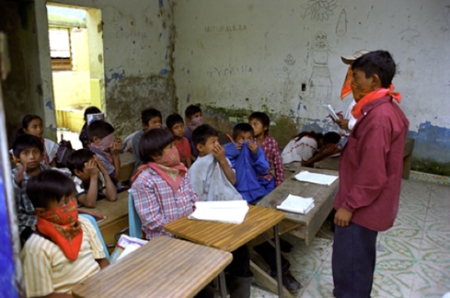
Autonomía zapatista. Otro mundo es posible
Zapatista Autonomy. Other world is possible
Tipo de producción/Type of Production
Documental/Documentary
Año de producción/Production Year
2008
País/Country
México
Duración/Running time
70 min.
Producción/Production
Dirección/Director
Juan E. García
Guion/Screenplay
Cristina Híjar González
Fotografía/Cinematography
Juan E. García
Edición/Editing
Adriana Casasola
Sonido/Sound
Astro Estudio
Juan E. García
Guion/Screenplay
Cristina Híjar González
Fotografía/Cinematography
Juan E. García
Edición/Editing
Adriana Casasola
Sonido/Sound
Astro Estudio
Sinopsis/Synopsis
En uno de los comunicados del EZLN (agosto de 2004), el Subcomandante Marcos planteaba: Por eso les digo que vengan, que caminen los pueblos y que ahora sí le pongan audio e imagen a este video. Este proyecto responde a esa invitación a partir de considerar que la autonomía indígena, el logro más tangible y destacable del movimiento zapatista, se plantea como un nuevo orden político que bajo el principio de mandar obedeciendo muestra al mundo entero la posibilidad de construcción de nuevas relaciones sociales y un nuevo ejercicio político democrático a partir de la capacidad creativa de la resistencia. Si bien el documental destaca los logros y avances del proceso autonómico zapatista, no podemos dejar de lado el contexto en el que se realiza: la ocupación militar, los grupos paramilitares, la complicidad y hostigamiento de los gobiernos federal, estatal y municipal, amenazas y enemigos permanentes de las comunidades organizadas que, pese a todo, avanzan y nos muestran otra realidad en curso.
In one of the press release from the EZLN (August 2004), Subcommander Marcos said: So I tell you to come, walk thetowns and put audio and image to this video. This project responds to this invitation starting from the consideration that the indigenous autonomy, the most concrete and important achievement of the Zapatista movement, raises as a new political order that under the principle of govern obeying, shows the world the possibility of constructing new social relations and a new democratic political practice derived from the creative capacity of resistance. Even though this documentary emphasizes the achievements of the Zapatista autonomous process, we can´t leave behind the context in which it develops: the military occupation, the paramilitary groups, the complicity and harassment of the federal, state and municipal governments.
In one of the press release from the EZLN (August 2004), Subcommander Marcos said: So I tell you to come, walk thetowns and put audio and image to this video. This project responds to this invitation starting from the consideration that the indigenous autonomy, the most concrete and important achievement of the Zapatista movement, raises as a new political order that under the principle of govern obeying, shows the world the possibility of constructing new social relations and a new democratic political practice derived from the creative capacity of resistance. Even though this documentary emphasizes the achievements of the Zapatista autonomous process, we can´t leave behind the context in which it develops: the military occupation, the paramilitary groups, the complicity and harassment of the federal, state and municipal governments.
Compañías productoras/Production companies
Arte, Música y Video, S.A. de C.V.
Formato/Format
DVD
Locación/Location
Chiapas (México)
Contacto/Contact
Arte, Música y Video, S.A. de C.V.
Av. 5 de Mayo 492
Col. Merced Gómez
CP 01600, Álvaro Obregón, Ciudad de México
Tels.: (52-55) 5593 9177
info@artemusicavideo.com.mx
contacto@autonomiazapatista.com
Enlace a página 1
Av. 5 de Mayo 492
Col. Merced Gómez
CP 01600, Álvaro Obregón, Ciudad de México
Tels.: (52-55) 5593 9177
info@artemusicavideo.com.mx
contacto@autonomiazapatista.com
Enlace a página 1
¿Detectaste algún error en este registro?
Fecha de última modificación: 18 de enero del 2010, 17:08
Información proporcionada por:
Red Nacional de Información Cultural
Instituto Mexicano de Cinematografía
u-cm
Información proporcionada por:
Red Nacional de Información Cultural
Instituto Mexicano de Cinematografía
u-cm
